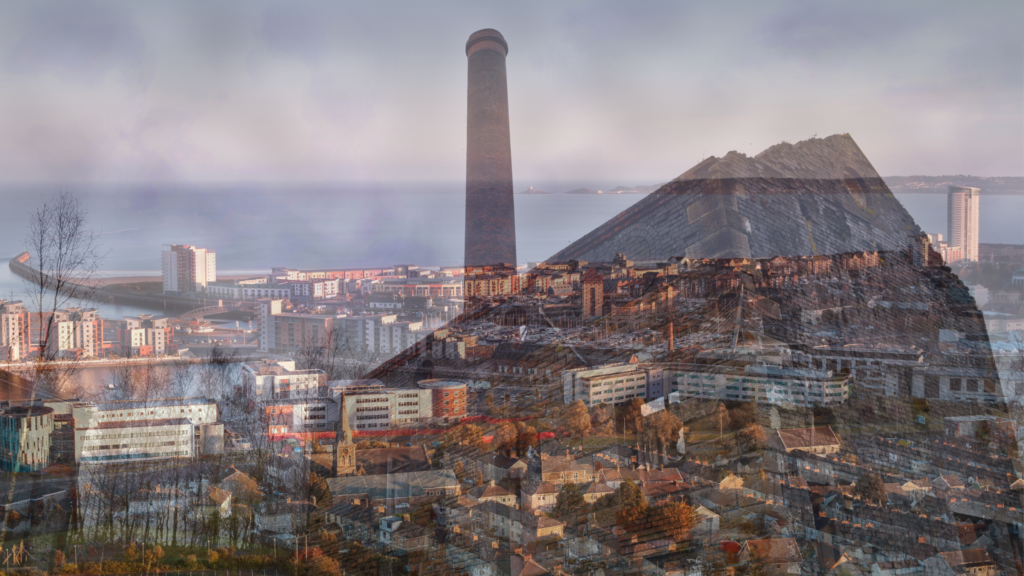
Introduction
Swansea, a coastal city in Wales, underwent a remarkable transformation during the Industrial Revolution. From a modest market town, it evolved into a bustling industrial hub, leaving an indelible mark on the landscape of 19th-century Britain. This period was characterised by rapid technological advancements, economic growth, and significant social changes. But what made Swansea stand out? Let’s delve into the history and uncover the power behind Swansea’s rise during this transformative era.
Swansea Before the Industrial Revolution
Before the Industrial Revolution, Swansea was primarily a market town with a modest population engaged in agriculture and small-scale crafts. The town’s strategic location by the sea had always been advantageous, facilitating trade and fishing. However, it was the discovery of abundant natural resources, particularly coal and copper, that set the stage for Swansea’s industrial boom.
The Catalyst: Natural Resources
Swansea’s abundance of coal and its proximity to copper deposits were critical factors in its transformation. The coal from the South Wales valleys provided a cheap and efficient energy source essential for powering the burgeoning industries. The town’s location on the Bristol Channel made it an ideal spot for importing and exporting goods, linking Swansea to the broader global trade networks.
The Copperopolis Era
During the Industrial Revolution, Swansea earned the nickname “Copperopolis.” This was due to its dominance in the copper smelting industry. By the mid-19th century, Swansea was producing a significant portion of the world’s copper. The copper industry brought wealth and development to the area, establishing Swansea as a key player in the global industrial landscape.
Key Figures and Innovations
Notable figures like John Henry Vivian and the development of the Hafod Copperworks were instrumental in advancing the copper industry. The innovative smelting techniques and the establishment of extensive smelting operations attracted workers and investors, fuelling further growth. The smelting process required vast amounts of coal, linking the coal and copper industries in a symbiotic relationship that propelled Swansea’s industrial economy.
Industrial Diversification
While copper was the cornerstone, Swansea’s industrial base diversified throughout the 19th century. The town saw the rise of other industries, including iron, tinplate, and pottery. This diversification not only fortified the local economy but also fostered a culture of innovation and resilience.
The Iron and Tinplate Industries
The growth of the iron industry, fuelled by local coal and iron ore, led to the development of ironworks and foundries. The tinplate industry, which involved coating iron sheets with tin, also thrived in Swansea. These industries created a robust industrial ecosystem, attracting skilled labor and fostering technological advancements.
Social and Economic Impact
The industrial boom brought profound social and economic changes to Swansea. The population surged as people flocked to the town for employment opportunities. The influx of workers led to urbanisation, with new housing, infrastructure, and public services emerging to accommodate the growing population.
Urbanisation and Infrastructure
Swansea’s urban landscape transformed with the construction of workers’ housing, schools, and hospitals. Infrastructure improvements, including the development of the Swansea Canal and railways, enhanced transportation and trade, linking Swansea to other industrial centres and markets.
Challenges and Living Conditions
However, rapid industrialisation also brought challenges. Overcrowded housing, poor sanitation, and harsh working conditions were common issues. The rise of labor movements and unions during this period highlighted the need for improved working conditions and workers’ rights, leading to gradual social reforms.
Technological Advancements
Technological innovation was at the heart of Swansea’s industrial success. Advances in smelting techniques, steam engine technology, and transportation revolutionised production processes and efficiency. The introduction of the Bessemer process in steelmaking and the development of more efficient steam engines had a lasting impact on industrial practices.
Swansea’s Legacy
The legacy of Swansea’s Industrial Revolution era is evident in the city’s continued industrial and cultural significance. The foundations laid during the 19th century paved the way for future growth and development. Today, Swansea is known for its vibrant cultural scene, academic institutions, and ongoing contributions to industry and technology.
Conclusion
Swansea’s journey during the Industrial Revolution is a testament to the power of natural resources, innovation, and industrial diversification. From “Copperopolis” to a diversified industrial hub, Swansea’s transformation had a lasting impact on the city’s identity and economic trajectory. The story of Swansea during the Industrial Revolution highlights the profound changes that shaped not only the city but also the broader industrial landscape of Britain.
FAQs
Q: Why was Swansea called “Copperopolis”?
A: Swansea earned the nickname “Copperopolis” due to its dominance in the copper smelting industry during the Industrial Revolution.
Q: What were the main industries in Swansea during the Industrial Revolution?
A: The main industries included copper smelting, iron production, tinplate manufacturing, and pottery.
Q: How did the Industrial Revolution impact the population of Swansea?
A: The population surged as people moved to Swansea for job opportunities, leading to urbanisation and the development of housing and infrastructure.
Q: What were some of the technological advancements in Swansea during the Industrial Revolution?
A: Advancements included improved smelting techniques, the development of steam engines, and the introduction of the Bessemer process in steelmaking.
Q: How did industrialisation affect living conditions in Swansea?
A: While it brought economic growth, industrialisation also led to overcrowded housing, poor sanitation, and challenging working conditions.
Further Reading
For more on Swansea’s fascinating history during the Industrial Revolution, check out these resources:
- Swansea Museum
- The National Archives: Industrial Revolution
- Copperopolis: Landscapes of the Early Industrial Period in Swansea


Leave a Reply